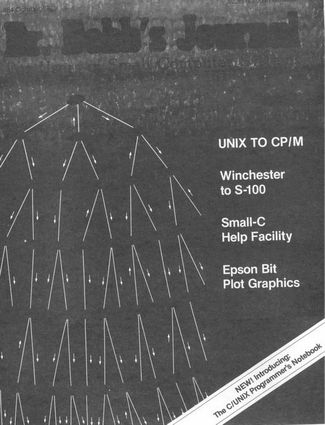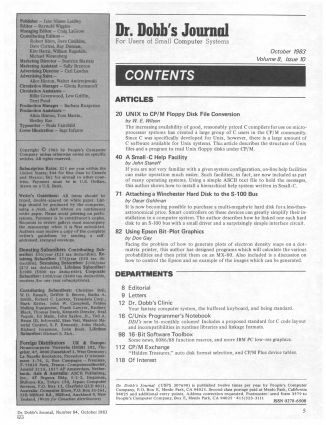
#Edito
TABLE OF CONTENTS
[author : W.E. Wilson]
The increasing availability of good, reasonably priced C compilers for use on microprocessor systems has created a large group of C users in the CP/M community. Since C was specifically developed for Unix, however, there is a large amount of C software available for Unix systems. This article describes the structure of Unix files and a program to read Unix floppy disks under CP/M.
[author : John Staneff]
If you are not very familiar with a given system configuration, on-line help facilities can make operation much easier. Such facilities, in fact, are now included as part of many operating systems. Using a simple ASCII text file to hold the messages, this author shows how to install a hierarchical help system written in Small-C.
[author : Oscar Goldman]
It is now becoming possible to purchase a multi-megabyte hard disk for a less-than-astronomical price. Smart controllers on these devices can greatly simplify their installation in a computer system. The author describes how he linked one such hard disk to an S-100 bus with a small driver and a surprisingly simple interface circuit.
[author : Don Gay]
Facing the problem of how to generate plots of electron density maps on a dot-matrix printer, this author has designed programs which will calculate the various probabilities and then print them on an MX-80. Also included is a discussion on how to control the Epson and an example of the images which can be generated.
[author : Dave Cortesi]
Your fantasy computer system, the buffered keyboard, and being standard.
[author : Anthony Skjellum]
DDJ’s new bi-monthly column! Includes a proposed standard for C code layout and incompatibilities in runtime libraries and linkage formats.
[author : Ray Duncan]
Some news, 8086/88 function macros, and more IBM PC low-res graphics.
[author : Robert Blum]
"Hidden Treasures," auto disk format selection, and CP/M Plus device tables.
[author : Michael Wiesenberg]
